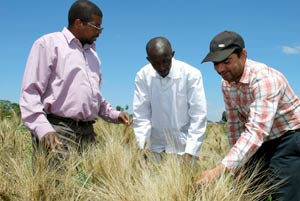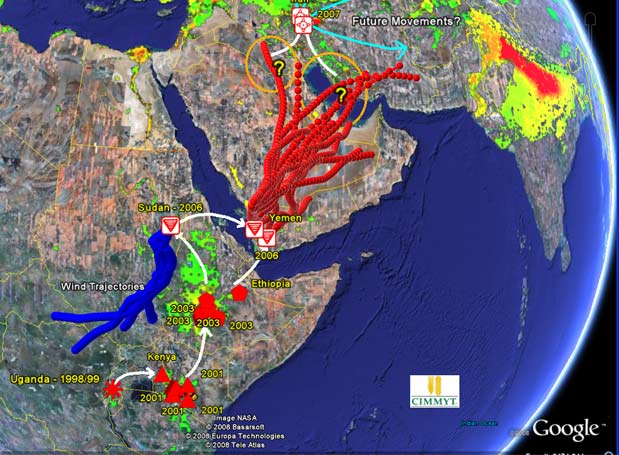|
December, 2008
Source:
CIMMYT e-newsletter vol
5 no 12
- December 2008
http://www.cimmyt.org/english/wps/news/2008/dec/stemrustKenya.htm

Plant breeders Peter
Njau, Godwin Macharia, and Davinder Singh (from left
to right) seek wheat lines that have race
"non-specific" resistance to Ug99. "This type of
resistance is considered effective against all races
of the pathogen and is durable," explains Singh.
"That is, it's hard for the pathogen to overcome."
|
A deadly new pathogen is carrying
off wheat farmers' harvests in eastern Africa, affecting the
balance of trade in countries like Kenya, and threatening vast
wheat lands in other developing countries. Kenyan and Ethiopian
researchers are working with CIMMYT to identify resistant wheats
for the world, and new technologies are helping track the
pathogen's spread.
According to Kenyan researcher Joseph Macharia, a new,
highly-virulent form of the wheat disease known as stem rust is
driving Kenyan wheat farmers off their land. "If farmers can't
grow wheat, they just abandon the field, or some may switch to
maize," says Macharia. "Wheat is a high-investment cereal, so if
farmers lose their crop, they lose their investment and can't
continue."
Stem rust is an age-old disease of wheat worldwide. Ug99, a new
strain of stem rust, first appeared in Uganda in 1998. It was
subsequently detected in Kenya in 2002 and Ethiopia in 2003, in
Sudan and Yemen in 2006, and in Iran in 2007. The pathogen is
expected to continue its migration to South and Central Asia,
through the Middle East and North Africa, riding on the winds or
by other means. Most currently-grown varieties in its path are
susceptible, and the wheat areas at risk represent 20% of the
global total and provide sustenance for 1 billion people.
In Kenya, Peter Njau, plant breeder and deputy director of the
Kenya Agricultural Research Institute (KARI) research station at
Njoro, says the loss of wheat harvests to the pathogen affect
both farmers and the national economy. "Wheat is the second-most
important crop in Kenya—we produce 350,000 tons every year," he
says, "but we need to import 450,000 tons more to meet national
consumption demands."
Finding safety in numbers
This year, Njau and his team worked with CIMMYT on the Njoro
station to test 20,000 wheat lines from more than 15 countries
for resistance to Ug99. Wheat scientists from most of these
countries came to Kenya to evaluate their material and see
first-hand the pathogen's damage. "This is a hot-spot for the
disease," Njau says, referring to Nakuru District in the Central
Rift Valley region of Kenya. "Disease incidence was so intense
this year that 85% percent of the lines proved susceptible, and
many supposedly resistant lines showed 20% greater infection
than they normally would. New variants of the pathogen are
appearing that overcome some of the most effective resistance
genes in wheat."
But there is hope, too, according to Njau. "The experimental
wheat variety Kingbird looked good under this year's conditions,
and has performed well in tests elsewhere." Derived from CIMMYT
germplasm, Kingbird is being used by the center to develop new
varieties whose seed can be multiplied and distributed quickly
to farmers in Ug99's probable path of migration. Njau has also
identified an experimental wheat variety from CIMMYT's
international stem rust resistance screening nursery that
out-yielded the best reference variety by 27% and the average
yield of varieties in the trial by 80%.
Global partners to arrest rust
Ethiopian wheat researchers are also partnering with CIMMYT to
evaluate wheat germplasm from around the globe for resistance to
the pathogen. "Kenya and Ethiopia are doing the world a great
service by conducting these trials," says CIMMYT wheat breeder
Davinder Singh, who is working in eastern Africa to combat Ug99.
"The countries also benefit by having access to seed of
resistant lines from international sources."
Efforts in both countries form part of the Borlaug Global Rust
Initiative, led by Cornell University and supported by a growing
number of donors, including the Bill & Melinda Gates Foundation,
the USAID-seed project, USDA-ARS, ICAR-India, Australia, China,
Arab Funds for Agricultural Development, FAO-training, and a
northwestern Mexican farmer association known as the Patronato.
Google Earth tracking system
To provide timely, reliable information to scientists and
decision makers in at-risk countries, scientists in CIMMYT’s
Geographical Information Systems (GIS) laboratory have used the
popular satellite-image virtual globe "Google Earth" to create a
program that tracks Ug99 occurrences, models wind trajectories
and potential dispersion paths for the pathogen, and summarizes
information on wheat production and susceptibility for countries
in Ug99's pathway. Called "RustMapper," the program is
automatically updated twice weekly.
|
 |
RustMapper is another component of
the Borlaug Global Rust Initiative, undertaken by CIMMYT, in
collaboration with the International Center for Agricultural
Research in the Dry Areas (ICARDA) and FAO, to fight the spread
of wheat rust fungal diseases.
Source:
http://www.cimmyt.org/english/wps/news/2008/dec/stemrustKenya.htm
|
|